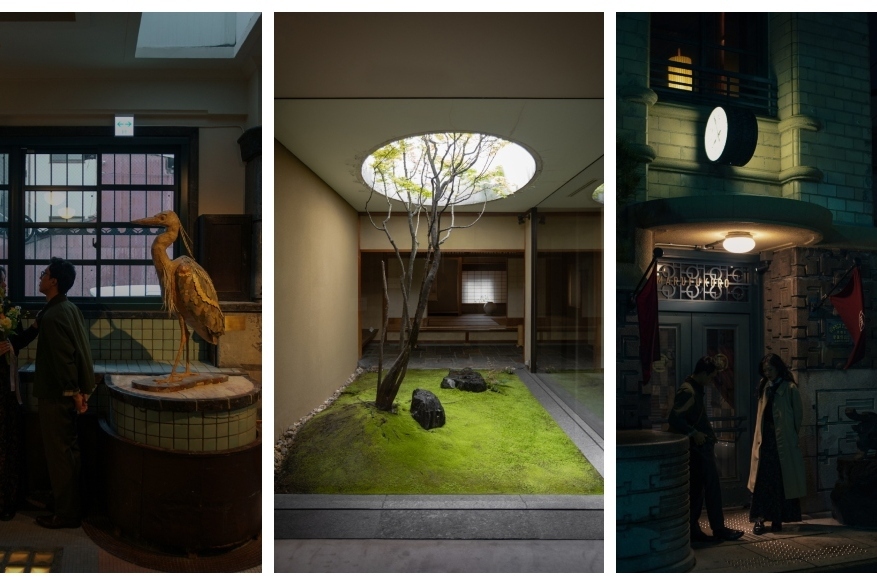What has there not been said of Kyoto? The city pulls in both locals and travellers chasing that romantic vision of Japan: centuries-old temples, winding lanes, and a cultural legacy that stretches back over a thousand years, when it served as the country’s capital from 794 to 1,868.
But Kyoto isn’t just temples and tea ceremonies. Past the tourist trail, there’s a sharper, design-driven side to the city waiting to be explored. Think experimental art spaces, contemporary architecture, and hidden gems that reframe what “traditional” can look like today.
Singapore photographer Lim Yu Heng
Lim Yu Heng
To that end, we’ve tapped on Singapore-born, Kyoto-based designer Lim Yu Heng to delve a little deeper into that side of the city. If you’re a Nipponophile, chances are, you’d have come across his photos on Instagram. The 32-year-old, who goes by Mazterz on the platform, has gained a fervent following who can’t get enough of his atmospheric images of some of Japan’s coolest architectural spots.
The self-taught photographer has been based in Tokyo since 2019 working as an architectural designer, before relocating to Kyoto at the start of 2024.
“There’s something incredibly inspiring about Kyoto. I feel like the essence of Japanese aesthetics really stems from this place,” says Lim. “Whether it’s temples, sukiya-style houses, galleries, or even everyday shops, there’s a consistent level of attention to detail and craftsmanship. That’s what makes it so rich visually and culturally.”
Ahead, Lim shares some of Kyoto’s best-kept secrets that are perfect for those with an eye for design and slow living:
KAHITSUKAN – KYOTO MUSEUM OF CONTEMPORARY ART
Lim Yu Heng
“This place feels like a quiet escape from the busy Gion area. I especially like visiting when they have photography exhibitions, which are held quite often. The atmosphere is calm, and if you take the elevator up, you’ll find a beautiful rooftop garden and even a small tea room. It’s a lovely spot to slow down and enjoy art in peace.This place feels like a quiet escape from the busy Gion area. I especially like visiting when they have photography exhibitions, which are held quite often. The atmosphere is calm, and if you take the elevator up, you’ll find a beautiful rooftop garden and even a small tea room. It’s a lovely spot to slow down and enjoy art in peace.”
271 Gionmachi Kitagawa, Higashiyama Ward, Kyoto, 605-0073
MARUFUKURO HOTEL
Lim Yu Heng
“This building was once Nintendo’s original headquarters and has since been transformed into a boutique hotel. The renovation, which involved Tadao Ando, preserved many of the original office elements, so stepping inside feels like walking back into history. A must-visit if you’re into design or curious about Nintendo’s roots.”
342 Kagiyacho, Kamogawa Nishiiri, Shomen-dori, Shimogyo-ku, 600-8126 Kyoto
GARDEN OF FINE ARTS KYOTO
Lim Yu Heng
“An outdoor museum designed by Tadao Ando, featuring large-scale ceramic reproductions of famous Western artworks, such as The Last Judgment. The use of concrete, water, and light gives it a peaceful, almost meditative feel. It’s a fascinating blend of Western classical art interpreted through Japanese design.”
Shimogamo Hangicho, Sakyo Ward, Kyoto, 606-0823
HOO KYOTO
“A beautifully renovated machiya turned cafe that embraces the raw honesty of traditional Japanese architecture. The stripped-back interior reveals the original timber rafters and earthen tsuchikabe walls, creating a quiet dialogue between structure and atmosphere. I love how the renovation respects the building’s age while blending in modern touches. The coffee is excellent too: rich, aromatic, and well-pulled.”
467-3 Hashimotocho, Nakagyo Ward, Kyoto, 604-0072
KYO AMAHARE
“This ceramic shop is nestled inside a renovated machiya, and entering feels like stepping into someone’s private home. You move through layers of space—from the genkan, past the tsuboniwa courtyard, into a calm room filled with stunning ceramics. Each item on display captures the meticulous craftsmanship and refined aesthetic of Japanese artisanship. It’s a quiet, contemplative space that celebrates the shokunin spirit.”
127 Aburayacho, Nakagyo Ward, Kyoto, 604-8063
SUI.
“A restaurant housed in a compact machiya that surprises you with its spatial openness and light-filled interior. The large double-height glass window opens the building to the street, blurring the boundary between inside and outside. It serves carefully prepared Western cuisine using fresh, high-quality ingredients, particularly meats. The retention of original timber and tsuchikabe highlights a quiet wabi-sabi aesthetic, where age, texture, and imperfection are celebrated.”
600-8052 Kyoto, Shimogyo Ward, Shioyacho, 81-1
CAFE BIBLIOTIC HELLO!
“One of my favourite spots in Kyoto, this cafe blends books, plants, and architecture into a warm, inviting space. The double-height interior with bookshelves gives a communal yet private atmosphere, ideal for catching up with friends or working. Outside, lush greenery lines the façade, shielding the space from harsh summer sunlight and offering a sense of retreat from the city.”
604-0951 Kyoto, Nakagyo Ward, Seimeicho, 650
APFR KYOTO
“A fragrance store designed within a renovated machiya, APFR offers a calm and immersive sensory experience. The dimmed, ambient lighting softens the space and complements the subtle scents of incense and oils, allowing visitors to fully focus on the fragrance. Every detail, from the material finishes to the airflow, seems carefully calibrated to evoke a serene, contemplative mood. It’s a perfect blend of design and scent curation.
439-1, Yamamoto-cho, Nakagyo-ku, Kyoto-shi, Kyoto 604-0933
HEISEI CHISHINKAN WING (KYOTO NATIONAL MUSEUM)
“Designed by Yoshio Taniguchi and opened in 2014, this wing is one of his later works and demonstrates his skill in modernist architecture. The material choices, proportions, and detailing—even down to how each stair tread and joint aligns—are precise. It’s a great example of how modern architecture can uphold traditional values of craft and harmony.”
527 Chayacho, Higashiyama Ward, Kyoto, 605-0931
KYUKYODO
“This is a historic stationery and incense shop founded in 1663, recently renovated by Hiroshi Naito. The architecture is refined, combining clean concrete, timber details, and soft light from a circular skylight above. The space is calm and elegant, complementing the traditional crafts on sale, including washi, brushes, and incense.
520 Shimohonnojimaecho, Nakagyo Ward, Kyoto, 604-8091


AloJapan.com